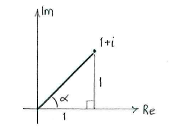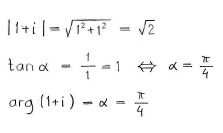Solution 3.3:1a
From Förberedande kurs i matematik 2
(Ny sida: {{NAVCONTENT_START}} <center> Bild:3_3_1a-1(2).gif </center> {{NAVCONTENT_STOP}} {{NAVCONTENT_START}} <center> Bild:3_3_1a-2(2).gif </center> {{NAVCONTENT_STOP}}) |
m |
||
| (4 intermediate revisions not shown.) | |||
| Line 1: | Line 1: | ||
| - | {{ | + | Powers are repeated multiplications and because multiplication is a relatively simple arithmetical operation when it is carried out in polar form, calculating powers also becomes fairly simple in polar form, |
| - | <center> [[ | + | |
| - | {{ | + | {{Displayed math||<math>\bigl(r(\cos\alpha + i\sin\alpha)\bigr)^n = r^n(\cos n\alpha + i\sin n\alpha)\,\textrm{.}</math>}} |
| - | {{ | + | |
| - | < | + | The equation above is called de Moivre's formula. |
| - | {{ | + | |
| + | The plan is therefore to rewrite <math>1+i</math> in polar form, raise the expression to the power <math>12</math> using de Moivre's formula and then to write the answer in the form <math>a+ib</math>. | ||
| + | |||
| + | <center>[[Image:3_3_1_a1.gif]] [[Image:3_3_1_a_text.gif]]</center> | ||
| + | |||
| + | Using the calculations above, we see that | ||
| + | |||
| + | {{Displayed math||<math>1+i = \sqrt{2}\Bigl(\cos\frac{\pi}{4} + i\sin\frac{\pi}{4} \Bigr)\,\textrm{.}</math>}} | ||
| + | |||
| + | De Moivre's formula now gives | ||
| + | |||
| + | {{Displayed math||<math>\begin{align} | ||
| + | (1+i)^{12} | ||
| + | &= \bigl(\sqrt{2}\,\bigr)^{12}\Bigl(\cos \Bigl(12\cdot\frac{\pi}{4}\Bigr) + i\sin \Bigl(12\cdot\frac{\pi}{4}\Bigr)\Bigr)\\[5pt] | ||
| + | &= 2^{(1/2)\cdot 12}\Bigl(\cos 3\pi + i\sin 3\pi\Bigr)\\[5pt] | ||
| + | &= 2^6(-1+i\cdot 0)\\[5pt] | ||
| + | &= 64\cdot (-1)\\[5pt] | ||
| + | &= -64\,\textrm{.} | ||
| + | \end{align}</math>}} | ||
Current revision
Powers are repeated multiplications and because multiplication is a relatively simple arithmetical operation when it is carried out in polar form, calculating powers also becomes fairly simple in polar form,
| \displaystyle \bigl(r(\cos\alpha + i\sin\alpha)\bigr)^n = r^n(\cos n\alpha + i\sin n\alpha)\,\textrm{.} |
The equation above is called de Moivre's formula.
The plan is therefore to rewrite \displaystyle 1+i in polar form, raise the expression to the power \displaystyle 12 using de Moivre's formula and then to write the answer in the form \displaystyle a+ib.


Using the calculations above, we see that
| \displaystyle 1+i = \sqrt{2}\Bigl(\cos\frac{\pi}{4} + i\sin\frac{\pi}{4} \Bigr)\,\textrm{.} |
De Moivre's formula now gives
| \displaystyle \begin{align}
(1+i)^{12} &= \bigl(\sqrt{2}\,\bigr)^{12}\Bigl(\cos \Bigl(12\cdot\frac{\pi}{4}\Bigr) + i\sin \Bigl(12\cdot\frac{\pi}{4}\Bigr)\Bigr)\\[5pt] &= 2^{(1/2)\cdot 12}\Bigl(\cos 3\pi + i\sin 3\pi\Bigr)\\[5pt] &= 2^6(-1+i\cdot 0)\\[5pt] &= 64\cdot (-1)\\[5pt] &= -64\,\textrm{.} \end{align} |
